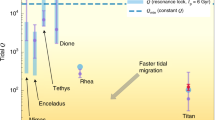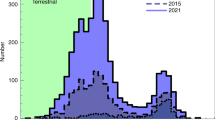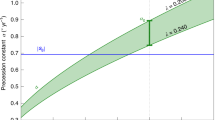Abstract
CONTROL of the 11-yr and longer cycles of solar activity tides raised on the Sun resulting from the gravitational pulls of the planets has often been suggested. Rudolf Wolf and R. C. Carrington were among the early astronomers who pointed out this possibility in the middle nineteenth century1. The close coincidence of the sidereal period of gravitationally important Jupiter (11.87 yr) with the mean period of the observed annual sunspot means (11.3 yr) raises the possibility of such a relationship; the range of possible configurations of the other planets allows a wide realm of other tidal periods and effects. In daily sunspot numbers, a small but consistent periodicity at the sidereal period of the planet Mercury has been found2, and a possible 178.7-yr period in sunspots (about twice the Gleissberg cycle) has been linked with multi-planet tidal influences3. Wood and Wood4 have applied a dynamical theory which includes all planets but Mars to reinforce their belief in a more than chance relationship. We reconstruct here Sun-centred planetary conjunctions and tidal potentials for the AD 1645–1715 period of sunspot absence (the Maunder Minimum). These are found to be effectively indistinguishable from patterns of conjunctions and power spectra of tidal potential in the modern era of a well-established 11-yr sunspot cycle. This places a new and difficult constraint on any tidal theory of sunspot formation.
This is a preview of subscription content, access via your institution
Access options
Subscribe to this journal
Receive 51 print issues and online access
$199.00 per year
only $3.90 per issue
Buy this article
- Purchase on Springer Link
- Instant access to full article PDF
Prices may be subject to local taxes which are calculated during checkout
Similar content being viewed by others
References
Ferris, G. A. J. Br. astro. Ass. 79, 385–388 (1969).
Bigg, E. K. Astr. J. 72, 463–466 (1967).
Jose, P. D. Astr. J. 70, 193–200 (1965).
Wood, R. M. & Wood, K. D. Nature 208, 129–131 (1965).
Eddy, J. A. Bull. Am. astr. Soc. 7, 365 (1975).
Eddy, J. A. Science 192, 1189 (1976).
Seidelman, P. K., Doggett, L. E. & deLuccia, M. R. Astr. J. 79, 57–60 (1974).
Okal, E. & Anderson, D. L. Nature 253, 511–513 (1975).
Cohen, T. J. & Lintz, P. R. Nature 250, 398–400 (1974).
Chen, W. Y. & Stegan, G. R. J. geophys. Res. 79, 3019–3022 (1974).
Ulrych, T. J. & Bishop, T. N. Rev. Geophys. Space Phys. 13, 183–200 (1975).
Waldmeier, M. Sunspot Activity for the Years 1600–1960 (M. Schulthe, Zurich, 1961).
Author information
Authors and Affiliations
Rights and permissions
About this article
Cite this article
SMYTHE, C., EDDY, J. Planetary tides during the Maunder Sunspot Minimum. Nature 266, 434–435 (1977). https://doi.org/10.1038/266434a0
Received:
Accepted:
Published:
Issue Date:
DOI: https://doi.org/10.1038/266434a0
This article is cited by
-
Empirical evidences for a planetary modulation of total solar irradiance and the TSI signature of the 1.09-year Earth-Jupiter conjunction cycle
Astrophysics and Space Science (2013)
-
Sun's inertial motion and luminosity
Solar Physics (1990)
-
Prolonged minima and the 179-yr cycle of the solar inertial motion
Solar Physics (1987)
-
Mathematical modelling of the sunspot cycle
Solar Physics (1981)
Comments
By submitting a comment you agree to abide by our Terms and Community Guidelines. If you find something abusive or that does not comply with our terms or guidelines please flag it as inappropriate.



